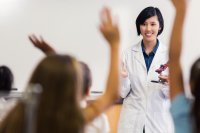Showcasing the Work of Professional Scientists
Students can invite local scientists to present their work at school to raise awareness of how new developments affect people’s lives.
Your content has been saved!
Go to My Saved Content.In order to introduce students at my school to real-life science content, several science students and I created a program called “Evening Out With a Scientist,” which was designed to raise community awareness of important developments and how those developments affected local citizens in their lives.
Once every six or seven weeks, this team of students hosted an open-to-the-public session, usually held in the school library on a Tuesday evening. The goals included giving students an opportunity to plan and host science-based presentations for the community; to provide alternate perspectives on science-based content and issues; and to give scientists who lived in or near the community an open platform to explain their work.
Planning the Evenings
The planning team was open to any student willing and able to meet. A core of students and I brainstormed to prepare a roster of scientists to be included in the yearlong program. We met during two consecutive activity periods—set aside for clubs, special meetings, etc.—in a counselor’s empty conference room. The original list had more than 50 candidates, including a virologist, a food scientist, and a zoologist.
Students volunteered to assist with making initial contacts—sending messages to websites and making phone calls to offices and labs. A few of the students were lucky to make a contact on their first attempt. More often, however, it took several attempts to receive any feedback at all.
The potential presenters followed up with me to tie down any loose ends. Once they were confirmed, we put their names on the school calendar and promised additional contact—a reminder—the week before their scheduled visit. At this point, the scientists also made any requests for technology that they might need for their presentation. Two of the students served on the staff in the media center, and both of them proved to be reliable and knowledgeable in providing cords, computers, and audiovisual components. For the most part, the scientists brought everything they needed, and we had very few technology issues.
The planning team also worked with 21 business partners of the school, who participated by bringing snacks or door prizes. For example, a local farm-to-table restaurant that worked with our school’s culinary department donated a cheese board with fruit, crackers, and flatbread. Another company donated a couple of hams for door prizes. It spoke highly of these companies’ commitment that there were several business partners in the audience at every presentation.
Another important component of Evening Out With a Scientist was media coverage, especially in the program’s infancy. We contacted the city newspaper and several radio and television studios in a three-county area. Their coverage provided a boost to our attendance.
Each session began at 6:30 p.m. with an informal reception. We had snacks, soda, coffee, and water, and the visiting scientists arrived early enough to enjoy meeting the audience before their presentation at 7. The average length of each program was about an hour, including a Q&A, and people usually mingled after the session. With easy cleanup, the last person walked out of the building no later than 8:45 p.m.
What Students Learned
The students on the planning team learned how much work it takes to make a public event happen. “What if no one shows up?” asked one student before the first session. I assured her that was unlikely, and the planning was a good lesson for them to learn to do everything in their power to make sure that they had an audience.
At the first session, about 60 members of the community came to hear a local physician talk about medical genetics. He had been involved in collecting data for the Human Genome Project and described his educational pathway to become a dermatologist and later a geneticist.
Other scientists included a radiologist from the local Air Force base hospital, an archaeologist from a nearby university, an epidemiologist, a civil engineer, and an arborist. The largest audience, more than 150 participants, came to see a severe-weather team.
Evening Out With a Scientist easily met our original goals of introducing students and the community to a range of ways to work in the sciences. A parent of one of my students told me later that as a result of her attendance, she was going back to school to work on her nursing degree, and even better, several students told us they had realized that being a scientist was “nothing like I thought—they’re just normal people who like to find out what makes things tick.”
With a bit of tweaking, teachers of any discipline can host similar events in their schools and communities. Such programs can help students and community members make vital links between content and their daily lives.
